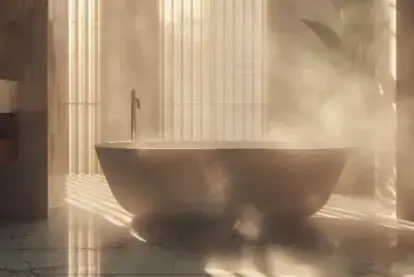
Stubborn Tablecloth Stains? Here’s How to Remove Them
Contact COIT for a professional cleaning!
We’ve all been there—dinner parties, family get-togethers, or even a simple meal that turns into a disaster for your tablecloth. Whether it's a red wine spill, a stubborn grease stain, or a splash of tomato sauce, these stains can be tricky to tackle.
At COIT, we understand how frustrating it is to see your favorite tablecloth get ruined, so we’ve compiled an expert guide to help you remove even the toughest stains from your tablecloth.
Know Your Stain Type
The first step in stain removal is identifying the type of stain you’re dealing with. Not all stains are created equal, and different stains require different approaches.
Here are some of the most common types of stains found on tablecloths:
Grease and oil stains
Grease and oil stains, like those from salad dressing or butter, cling stubbornly to fabric because they bond with the fibers. These stains can quickly spread, making them tough to tackle, especially if not treated right away.
Wine and beverage stains
Wine, particularly red wine, and dark beverages like coffee are notorious for leaving deep, noticeable marks on tablecloths. The pigments in these liquids can penetrate the fabric quickly, making them a challenge to remove if not addressed immediately
Food stains
Tomato sauce, berries, mustard, and chocolate are common culprits when it comes to stubborn food stains. These stains can cause tough discoloration due to the strong pigments and oils present in these foods, requiring prompt and careful treatment.
Ink stains
Ink stains, whether from a pen or marker, are particularly tough to remove because the ink is designed to be permanent. These stains can be highly visible, especially on light fabrics, and often need multiple treatments to fully lift.
Set-in stains
Set-in stains are older stains that have already bonded with the fabric, making them difficult to remove. While they require more effort, using the right methods can often lighten or even fully remove these stubborn marks.
Knowing the type of stain will help you choose the most effective cleaning method, so we recommend tailoring your stain removal process to the stain type for the best results.
Visit COIT’s Stain Remover Guide for more detailed stain removal advice.
Treat Your Stains Quickly
One of the most important steps you can take is to address the stain as soon as it happens. The longer a stain sits, the harder it is to remove.
Here’s what we recommend for quick action:
- Blot, Don’t Rub. The first instinct may be to rub the stain, but this can spread it further into the fabric. Instead, blot the area with a clean cloth or paper towel to absorb as much of the liquid as possible.
- Cold Water Rinse. For many stains (especially food and beverage stains), rinse the affected area under cold running water. Make sure to work from the back of the fabric to avoid pushing the stain deeper into the fibers.
- Pre-Treat with Detergent. Apply a small amount of liquid dish soap or laundry detergent directly to the stain and let it sit for about 15 minutes before laundering. This step works for most fresh stains and helps loosen up the material.
Quick action is key when it comes to removing stains, so make sure to address them immediately for the best chance of complete removal.
Removing Wine and Beverage Stains
Wine stains (especially red wine!) can cause panic, but there's no need to worry. Here’s how to remove them effectively:
- Blot and Rinse: Start by blotting the excess wine with a clean cloth or paper towel. Avoid rubbing, as this can spread the stain.
- Salt Treatment: After blotting, sprinkle the stained area generously with salt. Salt helps absorb the wine and can lift some of the color out of the fabric. Let the salt sit for a few minutes, then rinse with cold water.
- White Vinegar and Dish Soap: If the stain persists, mix one tablespoon of white vinegar with one tablespoon of liquid dish soap in two cups of warm water. Apply the mixture to the stain with a sponge, then blot until the stain is lifted.
- Launder: Once the stain is mostly gone, wash the tablecloth in the washing machine on a cold cycle, using a stain-removing laundry detergent.
Coffee and tea stains are another common issue:
- Immediate Blotting: As soon as the spill occurs, blot the stain with a paper towel.
- Baking Soda Paste: Mix baking soda and water to form a paste and apply it to the stain. Let it sit for 30 minutes, then rinse with cold water.
- Vinegar and Detergent: For tougher stains, apply a solution of vinegar and liquid dish soap before washing the tablecloth.
Tackling Grease and Oil Stains
Grease stains can be particularly stubborn because oil tends to bind with fabric fibers.
Here’s our expert method to get grease and oil stains out:
- Blot the Excess Grease: Use a paper towel or cloth to blot away as much of the grease as possible. Do this gently so you don’t spread the stain.
- Cornstarch or Baking Soda: After blotting, sprinkle cornstarch or baking soda over the stain to absorb the excess oil. Let it sit for 15 minutes, then brush it off with a soft brush or cloth.
- Liquid Dish Soap: Apply a few drops of grease-fighting liquid dish soap directly to the stain. Gently rub it in using a soft cloth, then let it sit for 15 minutes.
- Rinse and Wash: Rinse with cold water and launder the tablecloth in warm water. Be sure to check if the stain is gone before placing the tablecloth in the dryer; heat can set the stain permanently.
For old grease stains that have set in, you may need to repeat this process multiple times to fully remove the stain.
Removing Food Stains
Food stains, especially from colorful foods like berries and tomato sauce, can seem impossible to remove. However, with the right steps, you can restore your tablecloth to its original condition.
Tomato Sauce Stains
Start by scraping off any excess sauce with a blunt knife. Rinse the area with cold water, working from the back of the fabric. Apply liquid dish soap or laundry detergent directly to the stain, then rinse again. If the stain persists, soak the tablecloth in a solution of one part vinegar and two parts cold water for 30 minutes before laundering.
Berry Stains
Soak the stained area in cold water for 30 minutes to an hour. Then, create a solution of one tablespoon of dish soap and two tablespoons of white vinegar. Apply it to the stain and let it sit for 10 minutes. Afterward, wash the tablecloth as usual.
Chocolate Stains
Scrape off any excess chocolate, then rinse with cold water. Pre-treat with a stain remover or dish soap, then soak the tablecloth in warm water with laundry detergent for 30 minutes before laundering.
These methods are effective for fresh food stains, but older stains may require repeated treatments to fully lift the stain.
Ink Stains: A Different Beast
Ink stains, whether from a pen or marker, can be particularly stubborn.
Start by blotting the stain with rubbing alcohol, being careful not to spread the ink. Once most of the ink is lifted, apply liquid dish soap and gently work it into the fabric.
Rinse with cold water, repeating the process if necessary. For tougher stains, consider using a commercial ink remover.
Dealing with Set-In Stains
Set-in stains are older stains that have had time to bond with the fabric fibers, making them more difficult to remove. However, they’re not impossible to tackle.
Start by soaking the stained area in a vinegar and water solution for a few hours. Follow up by applying a paste of baking soda and water directly to the stain, letting it sit for 30 minutes before rinsing and laundering.
For especially tough stains, a small amount of hydrogen peroxide can be used, but be cautious with colored fabrics to avoid fading.
Keeping Your Tablecloth Stain-Free
Prevention is just as important as stain removal. Here are some tips to help keep your tablecloth looking pristine:
- Use table protectors or placemats during meals to catch spills before they hit the fabric.
- Act quickly when a spill happens to prevent the stain from setting.
- Regularly wash your tablecloths to keep them fresh and prevent stains from settling in.
- Be careful when drying your tablecloth—heat can set stains permanently, so make sure all stains are gone before using a dryer.
Our Product Recommendations for Stain Removal
As cleaning experts, we’ve tried a lot of products over the years. Here are some of our favorites:
- Liquid Dish Soap: Perfect for tackling grease and food stains.
- White Vinegar: A versatile option for most stains, especially those from food and beverages.
- Baking Soda: Great for absorbing grease and lifting stains.
- Hydrogen Peroxide: Excellent for tough, protein-based stains like food and blood.
- Commercial Stain Removers: Products like OxiClean or Shout can be handy for more persistent stains.
A Quick Reference Guide to Stains
To make things even easier, we’ve put together a quick reference guide that matches specific stains with the best removal methods:
- Red Wine: Blot, salt, white vinegar, and dish soap.
- Coffee/Tea: Blot, baking soda paste, vinegar, and detergent.
- Grease/Oil: Blot, cornstarch or baking soda, dish soap, and rinse.
- Tomato Sauce: Scrape, rinse, dish soap, vinegar soak, and launder.
- Berry Stains: Cold water soak, dish soap, vinegar, and wash.
- Chocolate: Scrape, cold water rinse, pre-treat, warm water soak, and launder.
- Ink: Blot with rubbing alcohol, apply soap and water, rinse, and repeat as necessary.
- Set-In Stains: Vinegar soak, baking soda paste, hydrogen peroxide, and repeat treatments as needed.
Caring for Your Tablecloth
Keeping your tablecloth in top condition requires proper care and storage. Here are some simple tips to help your tablecloth last for years:
Proper Storage
After cleaning, fold your tablecloth neatly and store it in a cool, dry place. This prevents moisture buildup, which can lead to mildew or mold. Avoid storing it in areas that are prone to dampness.
Shield from Sunlight
Fabrics can fade with prolonged exposure to direct sunlight, so it’s best to store your tablecloth in a shaded area or drawer where light can’t reach it.
Freshen with Linen Sprays
Before putting your tablecloth away, a light spritz of linen spray can keep it smelling fresh. Just be sure the spray is safe for the type of fabric you’re using.
These simple steps will help maintain your tablecloth’s appearance and extend its life.
When to Seek Professional Help
If you’ve tried everything and that stubborn stain just won’t budge, it might be time to call in the professionals.
At COIT, we offer specialized cleaning services that can handle even the most difficult stains. Our team has the expertise and tools needed to treat delicate fabrics and restore your tablecloth to its original condition.
Trust COIT for All Your Cleaning Needs
Removing stains from tablecloths doesn’t have to be a daunting task. With the right approach and products, you can tackle even the most stubborn stains and keep your tablecloths looking their best.
Remember, quick action is key, and knowing the type of stain you’re dealing with will guide you to the most effective solution.
And if you ever find yourself facing a stain that just won’t budge, don’t hesitate to reach out to COIT. We’re here to help with all your cleaning needs, from tablecloths to carpets, upholstery, and beyond.
Let us take the stress out of stain removal so you can focus on enjoying your meals and gatherings without worrying about the aftermath.



